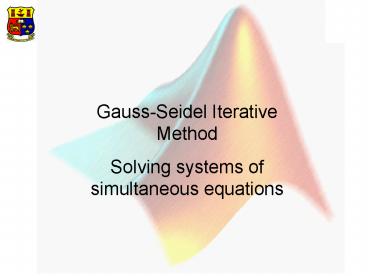GSIM - PowerPoint PPT Presentation
1 / 22
Title:
GSIM
Description:
A trunnion of diameter 12.363' has to be cooled from a room temperature of 80 F ... diametric contraction ?D of the trunnion in dry-ice/alcohol (boiling temperature ... – PowerPoint PPT presentation
Number of Views:57
Avg rating:3.0/5.0
Title: GSIM
1
Gauss-Seidel Iterative Method Solving systems of
simultaneous equations
2
Gauss-Seidel Method
An iterative method.
- Basic Procedure
- Algebraically solve each linear equation for xi
- Assume an initial guess solution array
- Solve for each xi and repeat
- Use absolute relative approximate error after
each iteration to check if error is within a
pre-specified tolerance.
3
Gauss-Seidel Method
Why?
The Gauss-Seidel Method allows the user to
control round-off error. Elimination methods
such as Gaussian Elimination and LU
Factorization/ Decomposition are prone to prone
to round-off error. Also If the physics/nature
of the problem are understood, a close initial
guess can be made, decreasing the number of
iterations needed.
4
Gauss-Seidel Method
Algorithm
A set of n equations and n unknowns
If the diagonal elements are non-zero Rewrite
each equation solving for the corresponding
unknown ex First equation, solve for x1 Second
equation, solve for x2
5
Gauss-Seidel Method
Algorithm
Rewriting each equation
From Equation 1
From equation 2
From equation n-1
From equation n
6
Gauss-Seidel Method
Algorithm
General form of each equation
7
Gauss-Seidel Method
Algorithm
General Form for any row i
How or where can this equation be used?
8
Gauss-Seidel Method
Solve for the unknowns
Assume an initial guess for X
Use rewritten equations to solve for each value
of xi. Important Remember to use the most recent
value of xi. Which means to apply values
calculated to the calculations remaining in the
current iteration.
9
Gauss-Seidel Method
Calculate the Absolute Relative Approximate Error
So when has the answer been found? The
iterations are stopped when the absolute relative
approximate error is less than a pre-specified
tolerance for all unknowns.
10
Example Thermal Coefficient
A trunnion of diameter 12.363 has to be cooled
from a room temperature of 80F before it is
shrink fit into a steel hub
The equation that gives the diametric contraction
?D of the trunnion in dry-ice/alcohol (boiling
temperature is -108F) is given by
11
Example Thermal Coefficient
The expression for the thermal expansion
coefficient, a a1 a2T a3T2 is obtained
using regression analysis and hence solving the
following simultaneous linear equations
We want to find the values of a1, a2,and a3
using Gauss Seidel Method.
12
Example Thermal Coefficient
The system of equations is
Initial Guess Assume an initial guess of
13
Example Thermal Coefficient
Rewriting each equation first iteration
14
Example Thermal Coefficient
Finding the absolute relative approximate error
At the end of the first iteration
The maximum absolute relative approximate error
is 100.00
15
Example Thermal Coefficient
Iteration 2
Using
from iteration 1
the values of ai are found
16
Example Thermal Coefficient
Finding the absolute relative approximate error
At the end of the second iteration
The maximum absolute relative approximate error
is 46.36050
17
Example Thermal Coefficient
Repeating more iterations, the following values
are obtained
! Notice After six iterations, the absolute
relative approximate errors are decreasing, but
are still high.
18
Example Thermal Coefficient
Repeating more iterations, the following values
are obtained
The value of closely approaches the true value of
19
Example Thermal Coefficient
The polynomial that passes through the three data
points is then
20
Gauss-Seidel Method Potential Pitfall
Diagonally dominant The coefficient on the
diagonal must be at least equal to the sum of the
other coefficients in that row and at least one
row with a diagonal coefficient greater than the
sum of the other coefficients in that row.
Non-Diagonally dominant Diagonally
dominant
Most physical systems, such as the previous
example, result in simultaneous linear equations
that have diagonally dominant coefficient matrices
21
Pseudo Code
22
Next lecture Curve Fitting and Interpolation































